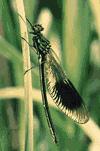- damselfly
-
/dam"zeuhl fluy'/, n., pl. damselflies.any of numerous slender, nonstinging insects of the order Odonata (suborder Zygoptera), distinguished from the dragonflies by having the wings folded back in line with the body when at rest.[1805-15; DAMSEL + FLY2]
* * *
Any of numerous predaceous insects of the suborder Zygoptera (order Odonata) having eyes that project to each side.When at rest, the damselfly holds its narrow, membranous, net-veined wings vertically rather than horizontally, unlike dragonflies. Damselflies are more delicate and weak-flying than dragonflies but are similar in having male copulatory organs at the front part of the abdomen. They commonly fly in tandem during mating. Male jewelwing damselfly (Calopteryx splendens).G.I. BernardOxford Scientific Films Ltd.
Male jewelwing damselfly (Calopteryx splendens).G.I. BernardOxford Scientific Films Ltd.* * *
▪ insectIntroductionany of a group of predatory, aerial insects that are in the order Odonata. Damselflies are found mainly near shallow, freshwater habitats and are graceful fliers with slender bodies and long, filmy, net-veined wings. Damselflies are generally smaller, more delicate, and fly weakly in comparison with dragonflies (suborder Anisoptera). Their colours can be stunningly vivid. Wingspans among the 2,600 damselfly species range from 18 mm (0.71 inch) to about 19 cm (7.5 inches) in Megaloprepus caerulatus, a giant damselfly of tropical Central and South America.Damselflies can usually be distinguished from dragonflies by their thinner, needlelike abdomens and by the way they hold their wings when at rest. With few exceptions, damselflies hold their wings vertically and together, rather than horizontally and spread apart. Also, the four wings are almost identical in size and shape and in the vein patterns. The large eyes of damselflies differ from those of dragonflies in that they are always widely separated, rather than close together or touching each other.Immature damselflies, called larvae (or sometimes nymphs or naiads), are, with very few exceptions, aquatic predators in freshwater habitats such as ponds, streams, and even tree holes. The larvae capture prey by shooting out the long, hinged lower lip, or “mask.” A damselfly larva is distinguishable from a dragonfly larva by its breathing apparatus. Most damselflies usually have three leaflike gills at the tip of the abdomen, whereas dragonflies have internal gills. After emerging from the larval stage, the damselfly takes to the air to feed and mate.The adults prey in flight, mainly on small insects. They are indiscriminate feeders except for the members of one family (Pseudostigmatidae), which are specialists that pluck spiders from their webs. In some species mating is preceded by elaborate courtship by the male. In two families the male hovers in front of the female while displaying his brightly coloured wings, abdomen, or legs, sometimes in combination. To mate, damselflies join together in the “wheel” position and commonly fly in tandem this way. Afterward, the male will usually remain attached to the female as she lays eggs. When doing so he retains his grip on the front portion of the female's thorax, using claspers located at the tip of his abdomen.Female damselflies normally use a bladelike ovipositor to place eggs inside plant tissue. Several species frequently lay eggs under water, the female at times remaining submerged for an hour or more. A male, usually her last mate, often waits above and may help her rise from the water after she surfaces.Additional ReadingBooksPhilip S. Corbet, Dragonflies: Behavior and Ecology of Odonata (1999), a definitive and well-illustrated source of information covering both dragonflies and damselflies.Ross E. Hutchins, The World of Dragonflies and Damselflies (1969), in addition to basic biological information, includes discussion of fossil ancestors and suggestions for collecting, identifying, and studying odonates.Minter J. Westfall, Jr., and Michael L. May, Damselflies of North America (1996).Rod Preston-Mafham and Ken Preston-Mafham, The Encyclopedia of Land Invertebrate Behaviour (1993), pp. 35–42, includes a detailed discussion of odonate reproductive behaviour, in addition to other topics briefly touched upon.Video documentariesThe Dragon & the Damsel (1983), written and produced by Pelham Aldrich-Blake. Narrated by Sir David Attenborough as part of the BBC natural history series “Wildlife on One.” Dragonfly (1988), produced by NHK Japan and TVOntario as part of the “Nature Watch” series.* * *
Universalium. 2010.
